Causes of Youth Unemployment: Skill Mismatch, Lack of Education, Capital Access, and Entrepreneurship
VerifiedAdded on 2023/06/12
|21
|4699
|99
AI Summary
This research paper analyses the causes of youth unemployment, including skill mismatch, lack of education, capital access, and entrepreneurship, and suggests solutions to reduce these causes. The paper provides a comprehensive analysis of the causes of youth unemployment and suggests solutions to reduce them.
Contribute Materials
Your contribution can guide someone’s learning journey. Share your
documents today.
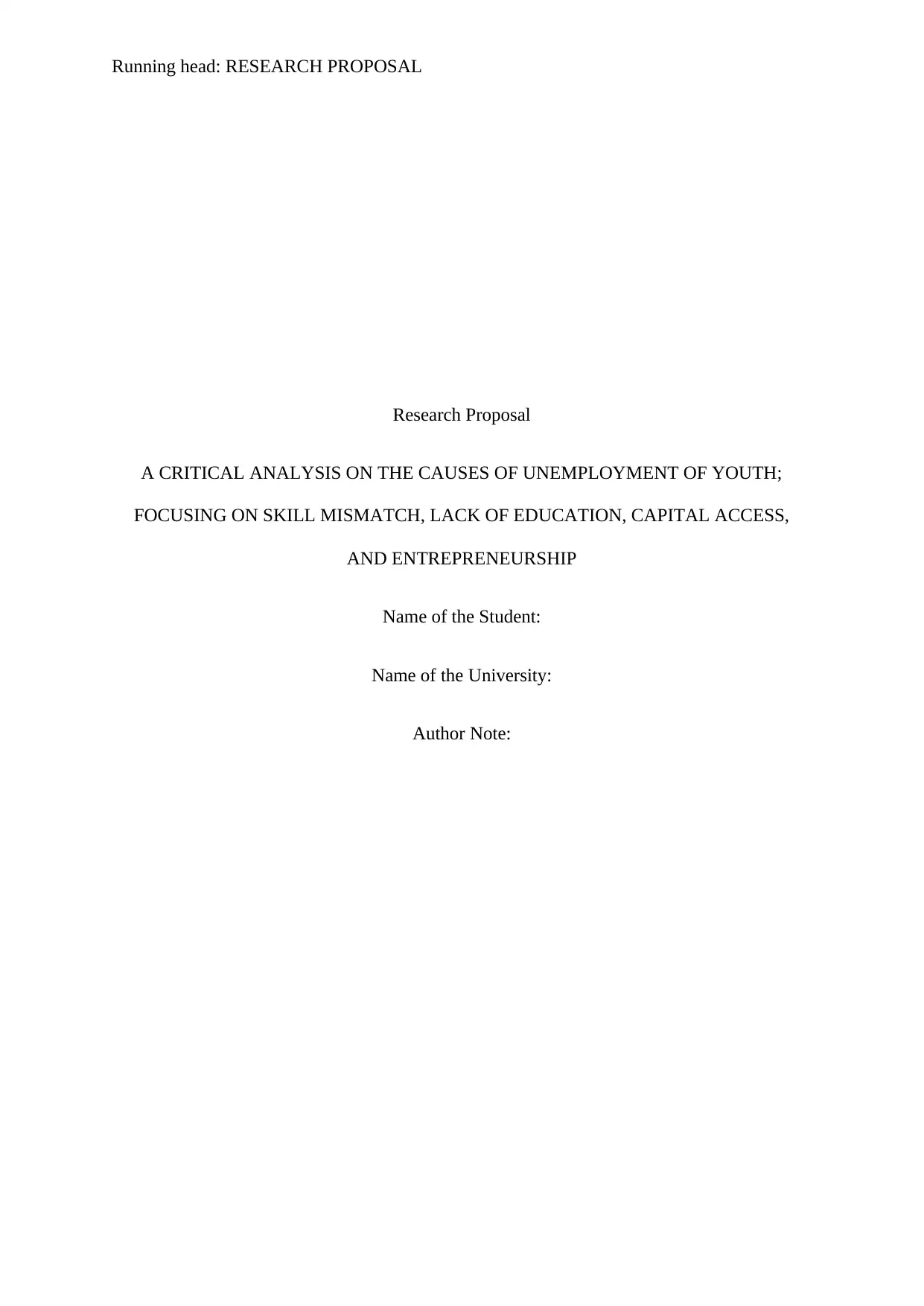
Running head: RESEARCH PROPOSAL
Research Proposal
A CRITICAL ANALYSIS ON THE CAUSES OF UNEMPLOYMENT OF YOUTH;
FOCUSING ON SKILL MISMATCH, LACK OF EDUCATION, CAPITAL ACCESS,
AND ENTREPRENEURSHIP
Name of the Student:
Name of the University:
Author Note:
Research Proposal
A CRITICAL ANALYSIS ON THE CAUSES OF UNEMPLOYMENT OF YOUTH;
FOCUSING ON SKILL MISMATCH, LACK OF EDUCATION, CAPITAL ACCESS,
AND ENTREPRENEURSHIP
Name of the Student:
Name of the University:
Author Note:
Secure Best Marks with AI Grader
Need help grading? Try our AI Grader for instant feedback on your assignments.

1RESEARCH PROPOSAL
Abstract
The aim of this study is to identify and analyse the causes of unemployment of youth. The
possible causes that are taken into account in this paper are skill mismatch, dearth of capital
access, lack of proper education, and unavailability of entrepreneurship. Unemployment is a
grave problem in the society and its consequences affect the society in a serious manner.
Unemployment is a serious problem that creates economic problems either directly or
indirectly. Moreover, youth unemployment is a global issue. The nations remains in a great
pressure due to the social and economic problems caused by the unemployment. The purpose
of the paper is to find certain root causes of the unemployment and finding solution to reduce
those causes so that the society will be benefitted. The unemployment should be reduced as
much as possible to avoid any sort of social revolution. The paper also examines the
importance of these causes to provide employment to the youth of the world. An elaborated
research methodology has been carried out that would lead the research process in the right
path. It can be assumed that the research will take a span of 24 weeks to be completed.
Abstract
The aim of this study is to identify and analyse the causes of unemployment of youth. The
possible causes that are taken into account in this paper are skill mismatch, dearth of capital
access, lack of proper education, and unavailability of entrepreneurship. Unemployment is a
grave problem in the society and its consequences affect the society in a serious manner.
Unemployment is a serious problem that creates economic problems either directly or
indirectly. Moreover, youth unemployment is a global issue. The nations remains in a great
pressure due to the social and economic problems caused by the unemployment. The purpose
of the paper is to find certain root causes of the unemployment and finding solution to reduce
those causes so that the society will be benefitted. The unemployment should be reduced as
much as possible to avoid any sort of social revolution. The paper also examines the
importance of these causes to provide employment to the youth of the world. An elaborated
research methodology has been carried out that would lead the research process in the right
path. It can be assumed that the research will take a span of 24 weeks to be completed.
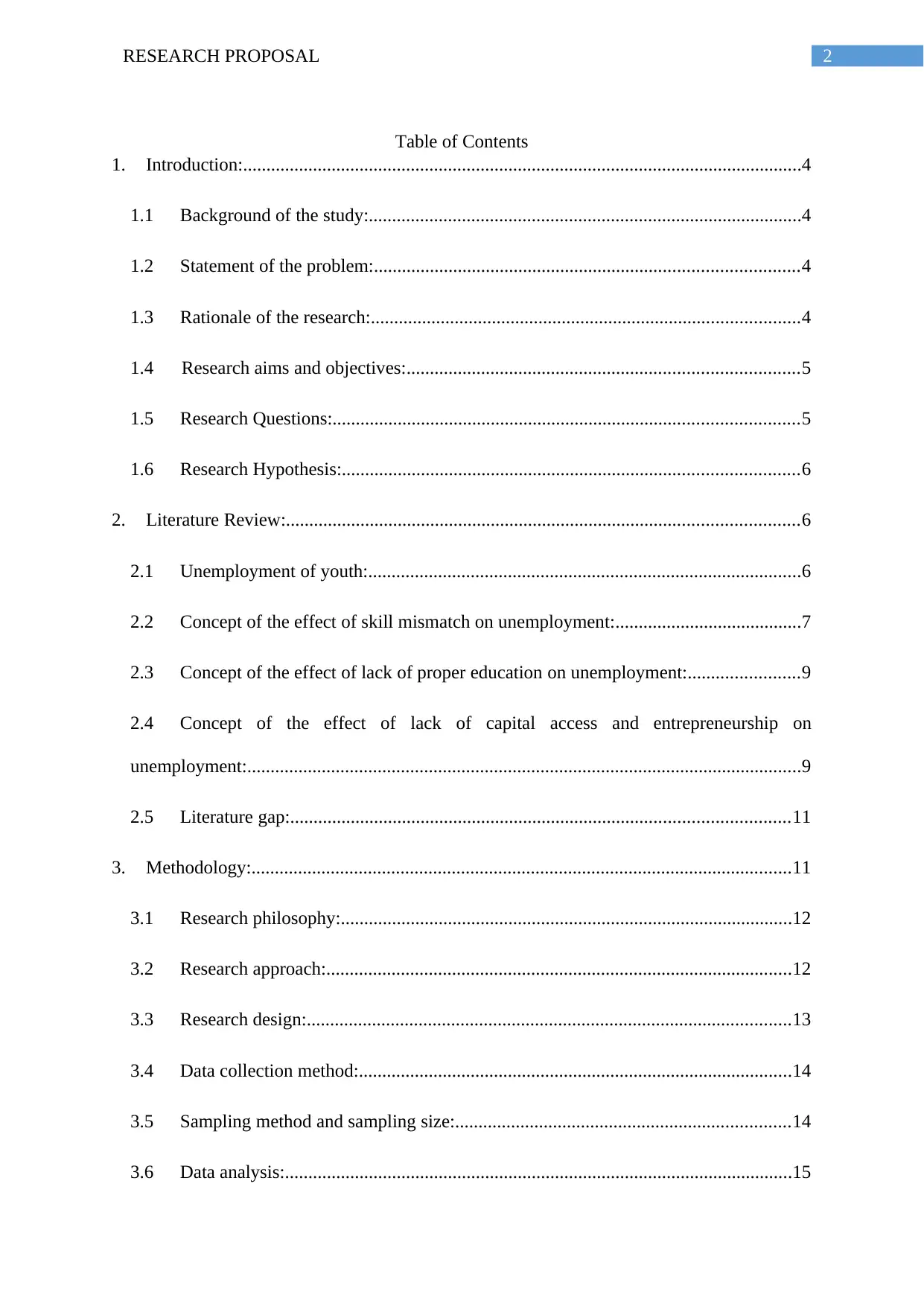
2RESEARCH PROPOSAL
Table of Contents
1. Introduction:........................................................................................................................4
1.1 Background of the study:.............................................................................................4
1.2 Statement of the problem:...........................................................................................4
1.3 Rationale of the research:............................................................................................4
1.4 Research aims and objectives:....................................................................................5
1.5 Research Questions:....................................................................................................5
1.6 Research Hypothesis:..................................................................................................6
2. Literature Review:..............................................................................................................6
2.1 Unemployment of youth:.............................................................................................6
2.2 Concept of the effect of skill mismatch on unemployment:........................................7
2.3 Concept of the effect of lack of proper education on unemployment:........................9
2.4 Concept of the effect of lack of capital access and entrepreneurship on
unemployment:.......................................................................................................................9
2.5 Literature gap:...........................................................................................................11
3. Methodology:....................................................................................................................11
3.1 Research philosophy:.................................................................................................12
3.2 Research approach:....................................................................................................12
3.3 Research design:........................................................................................................13
3.4 Data collection method:.............................................................................................14
3.5 Sampling method and sampling size:........................................................................14
3.6 Data analysis:.............................................................................................................15
Table of Contents
1. Introduction:........................................................................................................................4
1.1 Background of the study:.............................................................................................4
1.2 Statement of the problem:...........................................................................................4
1.3 Rationale of the research:............................................................................................4
1.4 Research aims and objectives:....................................................................................5
1.5 Research Questions:....................................................................................................5
1.6 Research Hypothesis:..................................................................................................6
2. Literature Review:..............................................................................................................6
2.1 Unemployment of youth:.............................................................................................6
2.2 Concept of the effect of skill mismatch on unemployment:........................................7
2.3 Concept of the effect of lack of proper education on unemployment:........................9
2.4 Concept of the effect of lack of capital access and entrepreneurship on
unemployment:.......................................................................................................................9
2.5 Literature gap:...........................................................................................................11
3. Methodology:....................................................................................................................11
3.1 Research philosophy:.................................................................................................12
3.2 Research approach:....................................................................................................12
3.3 Research design:........................................................................................................13
3.4 Data collection method:.............................................................................................14
3.5 Sampling method and sampling size:........................................................................14
3.6 Data analysis:.............................................................................................................15

3RESEARCH PROPOSAL
3.7 Time table:.................................................................................................................15
3.8 Ethical consideration:................................................................................................16
3.9 Research Limitations:................................................................................................17
References................................................................................................................................18
3.7 Time table:.................................................................................................................15
3.8 Ethical consideration:................................................................................................16
3.9 Research Limitations:................................................................................................17
References................................................................................................................................18
Secure Best Marks with AI Grader
Need help grading? Try our AI Grader for instant feedback on your assignments.
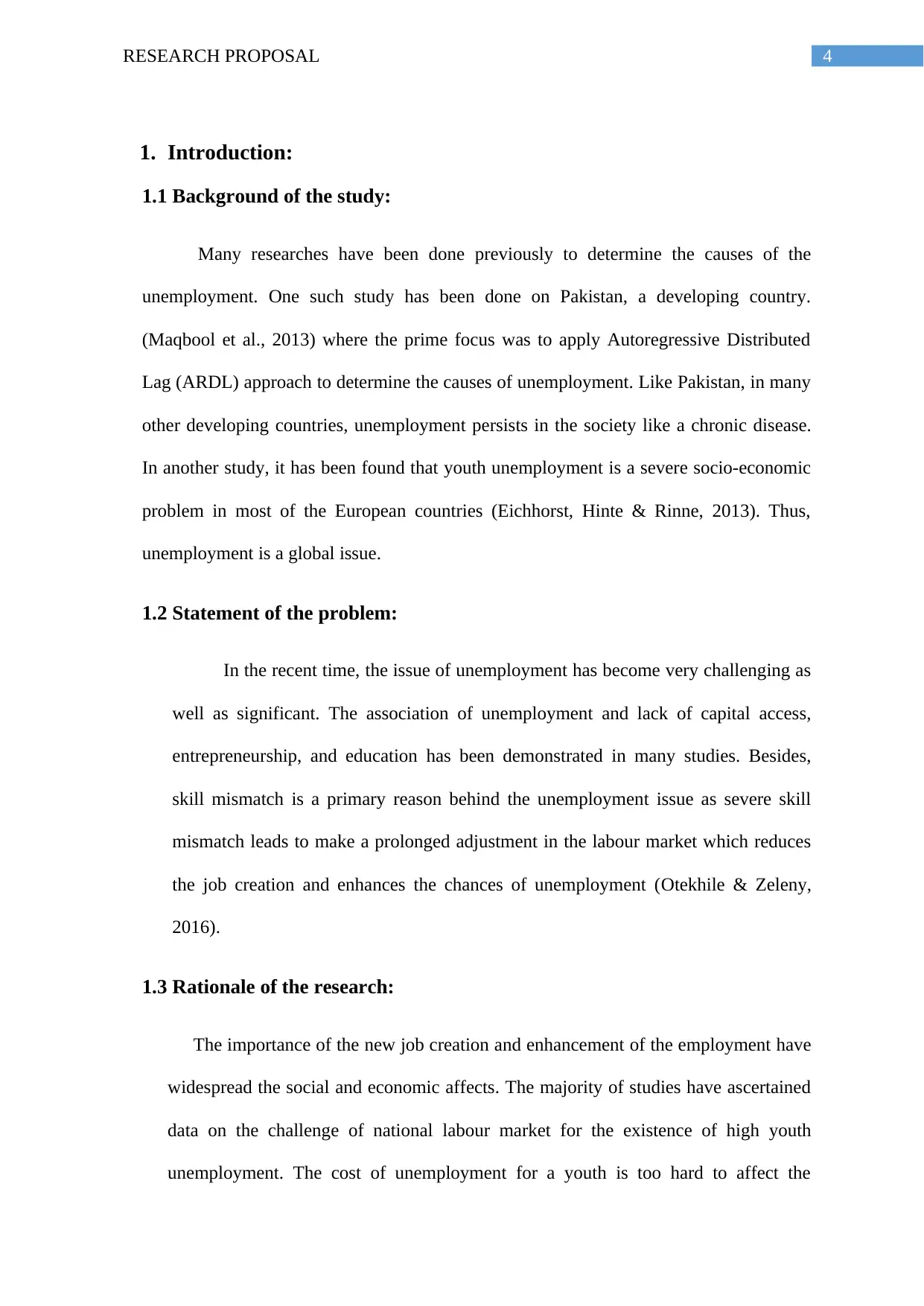
4RESEARCH PROPOSAL
1. Introduction:
1.1 Background of the study:
Many researches have been done previously to determine the causes of the
unemployment. One such study has been done on Pakistan, a developing country.
(Maqbool et al., 2013) where the prime focus was to apply Autoregressive Distributed
Lag (ARDL) approach to determine the causes of unemployment. Like Pakistan, in many
other developing countries, unemployment persists in the society like a chronic disease.
In another study, it has been found that youth unemployment is a severe socio-economic
problem in most of the European countries (Eichhorst, Hinte & Rinne, 2013). Thus,
unemployment is a global issue.
1.2 Statement of the problem:
In the recent time, the issue of unemployment has become very challenging as
well as significant. The association of unemployment and lack of capital access,
entrepreneurship, and education has been demonstrated in many studies. Besides,
skill mismatch is a primary reason behind the unemployment issue as severe skill
mismatch leads to make a prolonged adjustment in the labour market which reduces
the job creation and enhances the chances of unemployment (Otekhile & Zeleny,
2016).
1.3 Rationale of the research:
The importance of the new job creation and enhancement of the employment have
widespread the social and economic affects. The majority of studies have ascertained
data on the challenge of national labour market for the existence of high youth
unemployment. The cost of unemployment for a youth is too hard to affect the
1. Introduction:
1.1 Background of the study:
Many researches have been done previously to determine the causes of the
unemployment. One such study has been done on Pakistan, a developing country.
(Maqbool et al., 2013) where the prime focus was to apply Autoregressive Distributed
Lag (ARDL) approach to determine the causes of unemployment. Like Pakistan, in many
other developing countries, unemployment persists in the society like a chronic disease.
In another study, it has been found that youth unemployment is a severe socio-economic
problem in most of the European countries (Eichhorst, Hinte & Rinne, 2013). Thus,
unemployment is a global issue.
1.2 Statement of the problem:
In the recent time, the issue of unemployment has become very challenging as
well as significant. The association of unemployment and lack of capital access,
entrepreneurship, and education has been demonstrated in many studies. Besides,
skill mismatch is a primary reason behind the unemployment issue as severe skill
mismatch leads to make a prolonged adjustment in the labour market which reduces
the job creation and enhances the chances of unemployment (Otekhile & Zeleny,
2016).
1.3 Rationale of the research:
The importance of the new job creation and enhancement of the employment have
widespread the social and economic affects. The majority of studies have ascertained
data on the challenge of national labour market for the existence of high youth
unemployment. The cost of unemployment for a youth is too hard to affect the
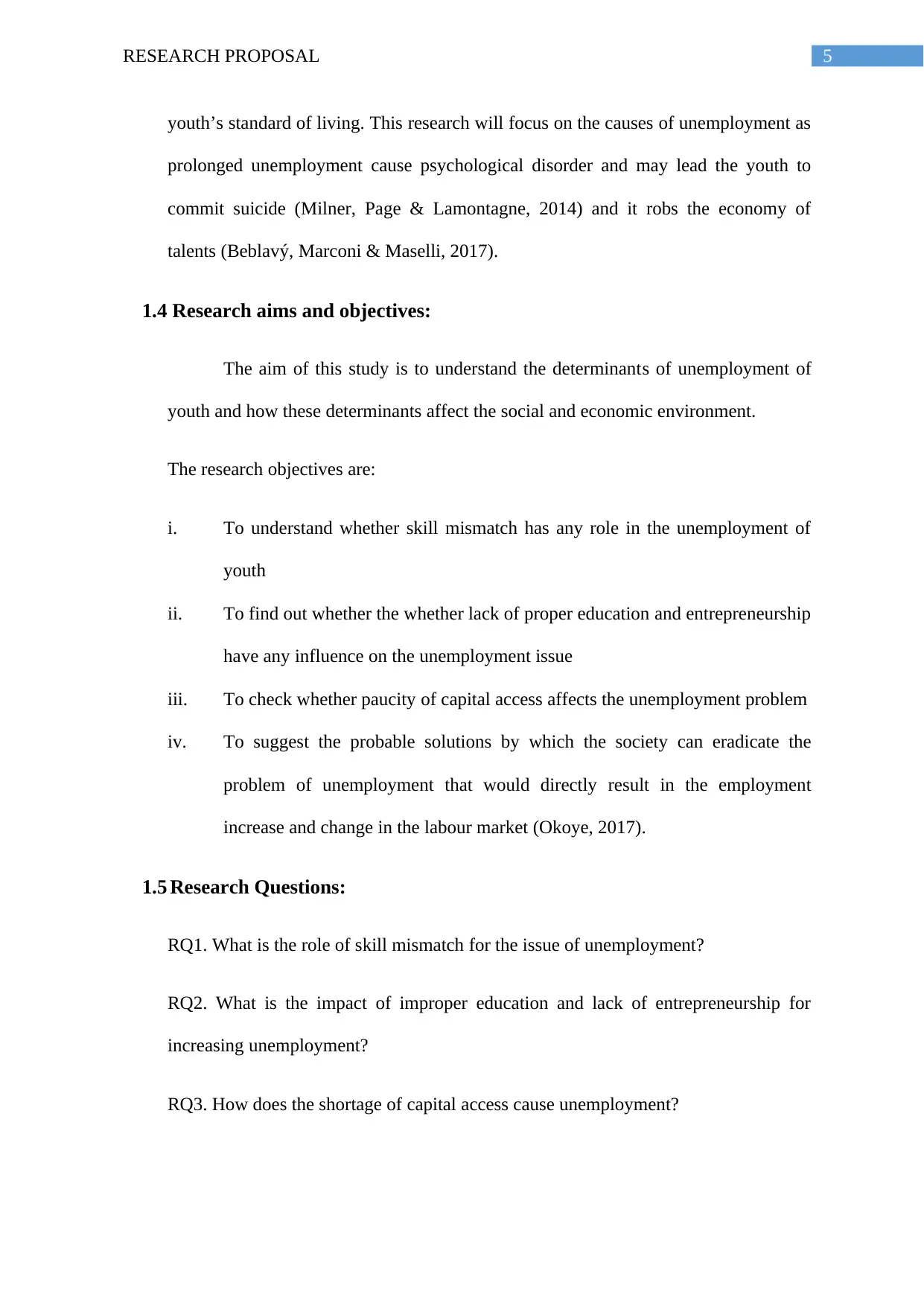
5RESEARCH PROPOSAL
youth’s standard of living. This research will focus on the causes of unemployment as
prolonged unemployment cause psychological disorder and may lead the youth to
commit suicide (Milner, Page & Lamontagne, 2014) and it robs the economy of
talents (Beblavý, Marconi & Maselli, 2017).
1.4 Research aims and objectives:
The aim of this study is to understand the determinants of unemployment of
youth and how these determinants affect the social and economic environment.
The research objectives are:
i. To understand whether skill mismatch has any role in the unemployment of
youth
ii. To find out whether the whether lack of proper education and entrepreneurship
have any influence on the unemployment issue
iii. To check whether paucity of capital access affects the unemployment problem
iv. To suggest the probable solutions by which the society can eradicate the
problem of unemployment that would directly result in the employment
increase and change in the labour market (Okoye, 2017).
1.5 Research Questions:
RQ1. What is the role of skill mismatch for the issue of unemployment?
RQ2. What is the impact of improper education and lack of entrepreneurship for
increasing unemployment?
RQ3. How does the shortage of capital access cause unemployment?
youth’s standard of living. This research will focus on the causes of unemployment as
prolonged unemployment cause psychological disorder and may lead the youth to
commit suicide (Milner, Page & Lamontagne, 2014) and it robs the economy of
talents (Beblavý, Marconi & Maselli, 2017).
1.4 Research aims and objectives:
The aim of this study is to understand the determinants of unemployment of
youth and how these determinants affect the social and economic environment.
The research objectives are:
i. To understand whether skill mismatch has any role in the unemployment of
youth
ii. To find out whether the whether lack of proper education and entrepreneurship
have any influence on the unemployment issue
iii. To check whether paucity of capital access affects the unemployment problem
iv. To suggest the probable solutions by which the society can eradicate the
problem of unemployment that would directly result in the employment
increase and change in the labour market (Okoye, 2017).
1.5 Research Questions:
RQ1. What is the role of skill mismatch for the issue of unemployment?
RQ2. What is the impact of improper education and lack of entrepreneurship for
increasing unemployment?
RQ3. How does the shortage of capital access cause unemployment?
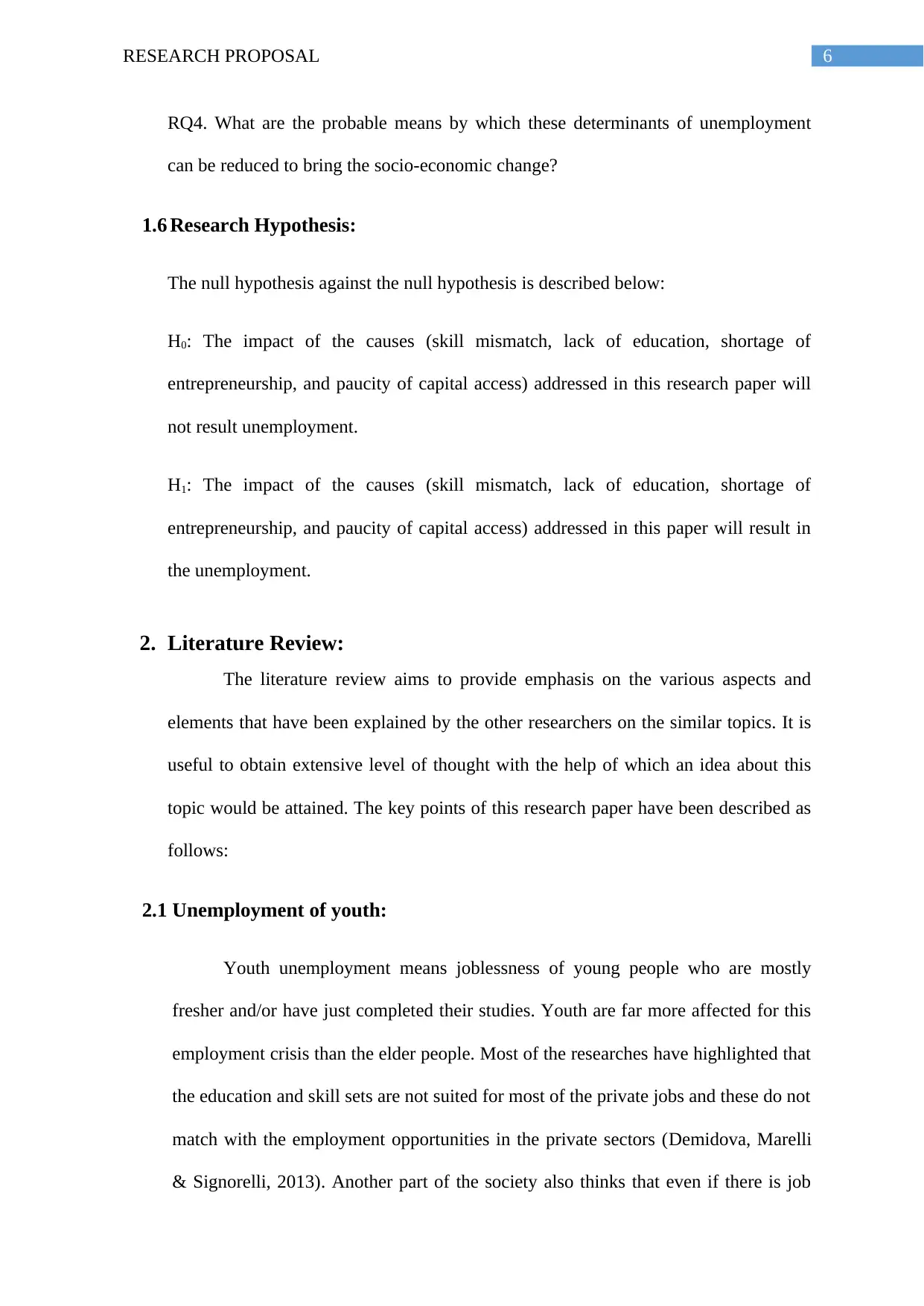
6RESEARCH PROPOSAL
RQ4. What are the probable means by which these determinants of unemployment
can be reduced to bring the socio-economic change?
1.6 Research Hypothesis:
The null hypothesis against the null hypothesis is described below:
H0: The impact of the causes (skill mismatch, lack of education, shortage of
entrepreneurship, and paucity of capital access) addressed in this research paper will
not result unemployment.
H1: The impact of the causes (skill mismatch, lack of education, shortage of
entrepreneurship, and paucity of capital access) addressed in this paper will result in
the unemployment.
2. Literature Review:
The literature review aims to provide emphasis on the various aspects and
elements that have been explained by the other researchers on the similar topics. It is
useful to obtain extensive level of thought with the help of which an idea about this
topic would be attained. The key points of this research paper have been described as
follows:
2.1 Unemployment of youth:
Youth unemployment means joblessness of young people who are mostly
fresher and/or have just completed their studies. Youth are far more affected for this
employment crisis than the elder people. Most of the researches have highlighted that
the education and skill sets are not suited for most of the private jobs and these do not
match with the employment opportunities in the private sectors (Demidova, Marelli
& Signorelli, 2013). Another part of the society also thinks that even if there is job
RQ4. What are the probable means by which these determinants of unemployment
can be reduced to bring the socio-economic change?
1.6 Research Hypothesis:
The null hypothesis against the null hypothesis is described below:
H0: The impact of the causes (skill mismatch, lack of education, shortage of
entrepreneurship, and paucity of capital access) addressed in this research paper will
not result unemployment.
H1: The impact of the causes (skill mismatch, lack of education, shortage of
entrepreneurship, and paucity of capital access) addressed in this paper will result in
the unemployment.
2. Literature Review:
The literature review aims to provide emphasis on the various aspects and
elements that have been explained by the other researchers on the similar topics. It is
useful to obtain extensive level of thought with the help of which an idea about this
topic would be attained. The key points of this research paper have been described as
follows:
2.1 Unemployment of youth:
Youth unemployment means joblessness of young people who are mostly
fresher and/or have just completed their studies. Youth are far more affected for this
employment crisis than the elder people. Most of the researches have highlighted that
the education and skill sets are not suited for most of the private jobs and these do not
match with the employment opportunities in the private sectors (Demidova, Marelli
& Signorelli, 2013). Another part of the society also thinks that even if there is job
Paraphrase This Document
Need a fresh take? Get an instant paraphrase of this document with our AI Paraphraser
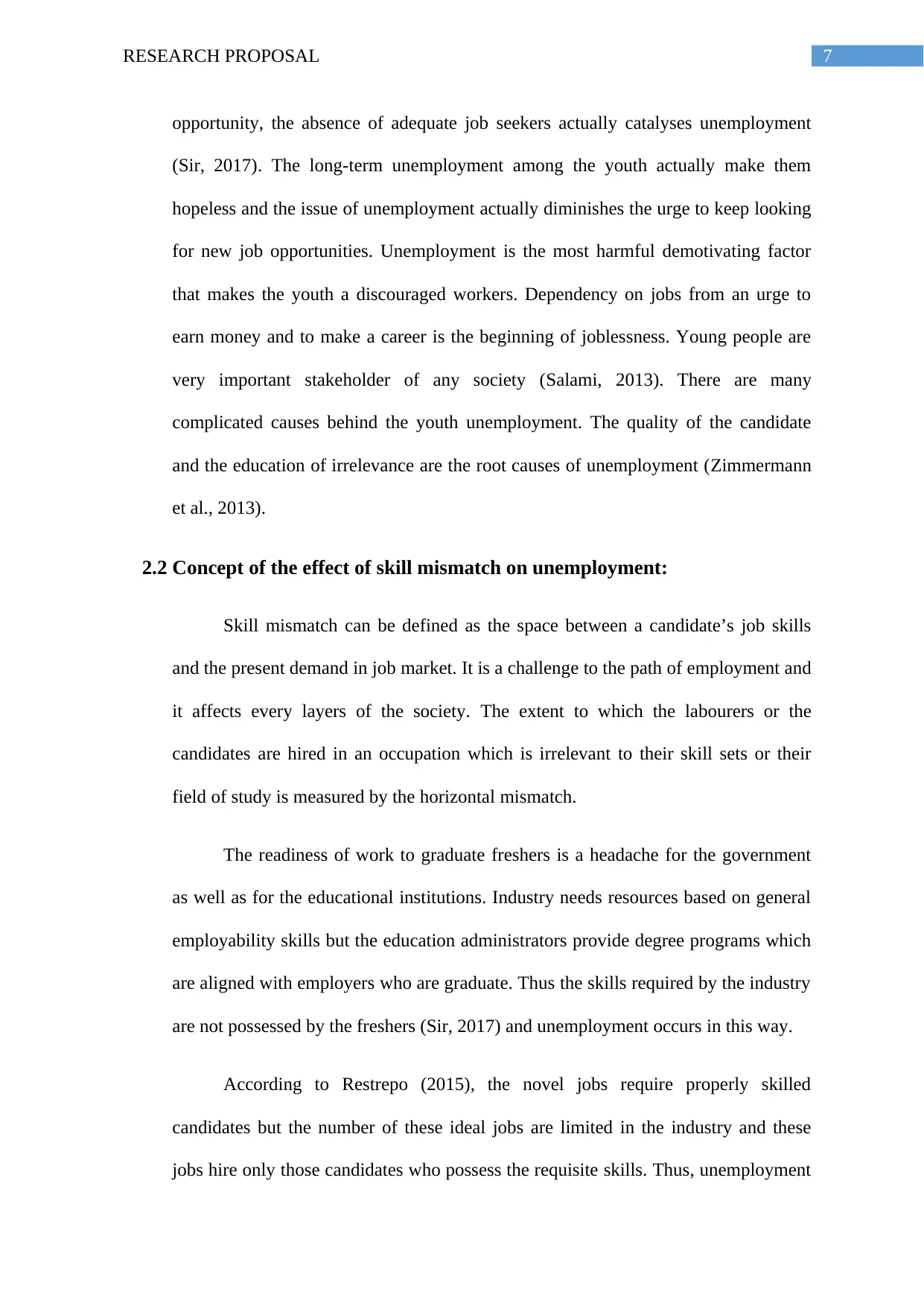
7RESEARCH PROPOSAL
opportunity, the absence of adequate job seekers actually catalyses unemployment
(Sir, 2017). The long-term unemployment among the youth actually make them
hopeless and the issue of unemployment actually diminishes the urge to keep looking
for new job opportunities. Unemployment is the most harmful demotivating factor
that makes the youth a discouraged workers. Dependency on jobs from an urge to
earn money and to make a career is the beginning of joblessness. Young people are
very important stakeholder of any society (Salami, 2013). There are many
complicated causes behind the youth unemployment. The quality of the candidate
and the education of irrelevance are the root causes of unemployment (Zimmermann
et al., 2013).
2.2 Concept of the effect of skill mismatch on unemployment:
Skill mismatch can be defined as the space between a candidate’s job skills
and the present demand in job market. It is a challenge to the path of employment and
it affects every layers of the society. The extent to which the labourers or the
candidates are hired in an occupation which is irrelevant to their skill sets or their
field of study is measured by the horizontal mismatch.
The readiness of work to graduate freshers is a headache for the government
as well as for the educational institutions. Industry needs resources based on general
employability skills but the education administrators provide degree programs which
are aligned with employers who are graduate. Thus the skills required by the industry
are not possessed by the freshers (Sir, 2017) and unemployment occurs in this way.
According to Restrepo (2015), the novel jobs require properly skilled
candidates but the number of these ideal jobs are limited in the industry and these
jobs hire only those candidates who possess the requisite skills. Thus, unemployment
opportunity, the absence of adequate job seekers actually catalyses unemployment
(Sir, 2017). The long-term unemployment among the youth actually make them
hopeless and the issue of unemployment actually diminishes the urge to keep looking
for new job opportunities. Unemployment is the most harmful demotivating factor
that makes the youth a discouraged workers. Dependency on jobs from an urge to
earn money and to make a career is the beginning of joblessness. Young people are
very important stakeholder of any society (Salami, 2013). There are many
complicated causes behind the youth unemployment. The quality of the candidate
and the education of irrelevance are the root causes of unemployment (Zimmermann
et al., 2013).
2.2 Concept of the effect of skill mismatch on unemployment:
Skill mismatch can be defined as the space between a candidate’s job skills
and the present demand in job market. It is a challenge to the path of employment and
it affects every layers of the society. The extent to which the labourers or the
candidates are hired in an occupation which is irrelevant to their skill sets or their
field of study is measured by the horizontal mismatch.
The readiness of work to graduate freshers is a headache for the government
as well as for the educational institutions. Industry needs resources based on general
employability skills but the education administrators provide degree programs which
are aligned with employers who are graduate. Thus the skills required by the industry
are not possessed by the freshers (Sir, 2017) and unemployment occurs in this way.
According to Restrepo (2015), the novel jobs require properly skilled
candidates but the number of these ideal jobs are limited in the industry and these
jobs hire only those candidates who possess the requisite skills. Thus, unemployment
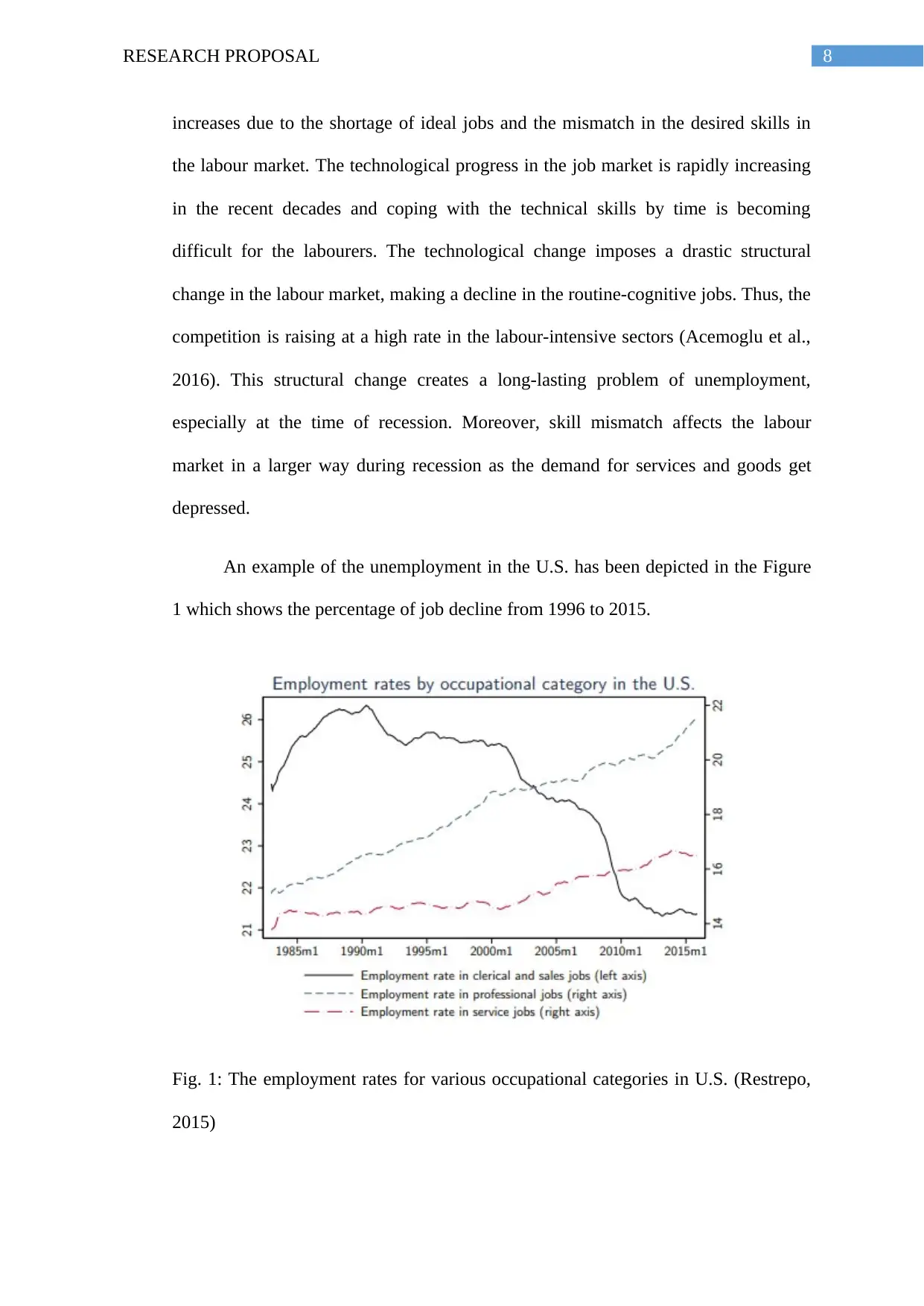
8RESEARCH PROPOSAL
increases due to the shortage of ideal jobs and the mismatch in the desired skills in
the labour market. The technological progress in the job market is rapidly increasing
in the recent decades and coping with the technical skills by time is becoming
difficult for the labourers. The technological change imposes a drastic structural
change in the labour market, making a decline in the routine-cognitive jobs. Thus, the
competition is raising at a high rate in the labour-intensive sectors (Acemoglu et al.,
2016). This structural change creates a long-lasting problem of unemployment,
especially at the time of recession. Moreover, skill mismatch affects the labour
market in a larger way during recession as the demand for services and goods get
depressed.
An example of the unemployment in the U.S. has been depicted in the Figure
1 which shows the percentage of job decline from 1996 to 2015.
Fig. 1: The employment rates for various occupational categories in U.S. (Restrepo,
2015)
increases due to the shortage of ideal jobs and the mismatch in the desired skills in
the labour market. The technological progress in the job market is rapidly increasing
in the recent decades and coping with the technical skills by time is becoming
difficult for the labourers. The technological change imposes a drastic structural
change in the labour market, making a decline in the routine-cognitive jobs. Thus, the
competition is raising at a high rate in the labour-intensive sectors (Acemoglu et al.,
2016). This structural change creates a long-lasting problem of unemployment,
especially at the time of recession. Moreover, skill mismatch affects the labour
market in a larger way during recession as the demand for services and goods get
depressed.
An example of the unemployment in the U.S. has been depicted in the Figure
1 which shows the percentage of job decline from 1996 to 2015.
Fig. 1: The employment rates for various occupational categories in U.S. (Restrepo,
2015)

9RESEARCH PROPOSAL
2.3 Concept of the effect of lack of proper education on unemployment:
The lack proper education means poor quality education. It is also a primary
cause of poverty. The poor quality education is controlled by certain factors. If the
management of the educational organisations do not implement proper and updated
educational methodologies then there will be a gap between the industrial
requirements and the available skill sets of the candidates. The traditional theory
oriented education is another important cause which stops the candidates from getting
the novel jobs. The other probable factors for poor education ("Poor quality
education and care", 2018) are few qualified educational instructors, inadequate
conditions to provide practical knowledge, and learning anything in an unsettled
environment. In addition to that, after completion of study, self-review is very
important which is absent in most of the educational organisations. Today’s poor
education leads unemployment (Görlich, Stepanok & Al-Hussami, 2013).
2.4 Concept of the effect of lack of capital access and entrepreneurship on
unemployment:
The entrepreneurship is the name of starting a new business by one’s own
design, thought, and management. The person who starts the entrepreneurship is
called an entrepreneur. The entrepreneurship can be classified into two types which
are as follows -
i. Necessity-based entrepreneurship where the entrepreneur has no option
left than earning a living and
ii. Opportunity-based entrepreneurship where the entrepreneur chooses to
start a business which is not borne.
2.3 Concept of the effect of lack of proper education on unemployment:
The lack proper education means poor quality education. It is also a primary
cause of poverty. The poor quality education is controlled by certain factors. If the
management of the educational organisations do not implement proper and updated
educational methodologies then there will be a gap between the industrial
requirements and the available skill sets of the candidates. The traditional theory
oriented education is another important cause which stops the candidates from getting
the novel jobs. The other probable factors for poor education ("Poor quality
education and care", 2018) are few qualified educational instructors, inadequate
conditions to provide practical knowledge, and learning anything in an unsettled
environment. In addition to that, after completion of study, self-review is very
important which is absent in most of the educational organisations. Today’s poor
education leads unemployment (Görlich, Stepanok & Al-Hussami, 2013).
2.4 Concept of the effect of lack of capital access and entrepreneurship on
unemployment:
The entrepreneurship is the name of starting a new business by one’s own
design, thought, and management. The person who starts the entrepreneurship is
called an entrepreneur. The entrepreneurship can be classified into two types which
are as follows -
i. Necessity-based entrepreneurship where the entrepreneur has no option
left than earning a living and
ii. Opportunity-based entrepreneurship where the entrepreneur chooses to
start a business which is not borne.
Secure Best Marks with AI Grader
Need help grading? Try our AI Grader for instant feedback on your assignments.
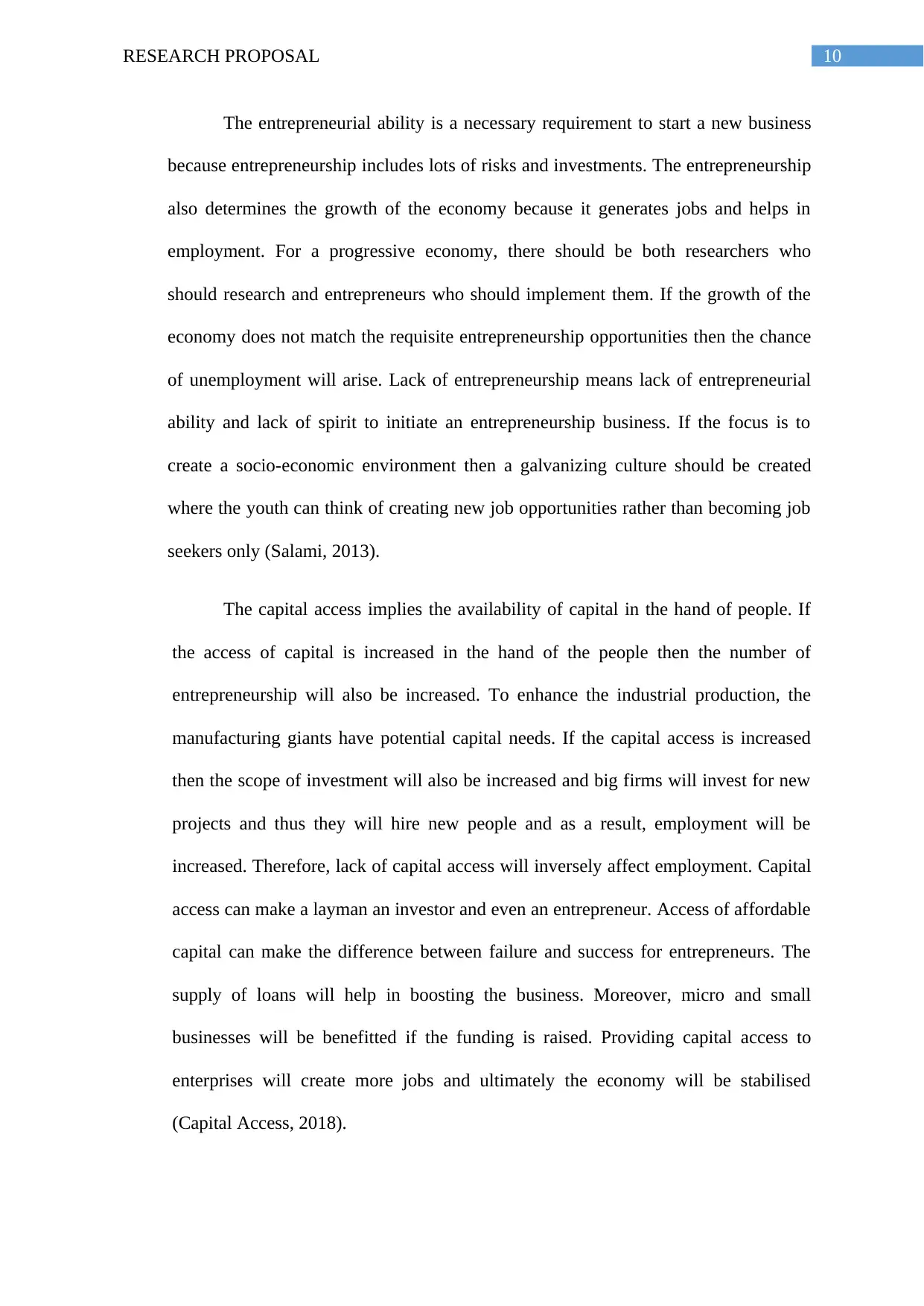
10RESEARCH PROPOSAL
The entrepreneurial ability is a necessary requirement to start a new business
because entrepreneurship includes lots of risks and investments. The entrepreneurship
also determines the growth of the economy because it generates jobs and helps in
employment. For a progressive economy, there should be both researchers who
should research and entrepreneurs who should implement them. If the growth of the
economy does not match the requisite entrepreneurship opportunities then the chance
of unemployment will arise. Lack of entrepreneurship means lack of entrepreneurial
ability and lack of spirit to initiate an entrepreneurship business. If the focus is to
create a socio-economic environment then a galvanizing culture should be created
where the youth can think of creating new job opportunities rather than becoming job
seekers only (Salami, 2013).
The capital access implies the availability of capital in the hand of people. If
the access of capital is increased in the hand of the people then the number of
entrepreneurship will also be increased. To enhance the industrial production, the
manufacturing giants have potential capital needs. If the capital access is increased
then the scope of investment will also be increased and big firms will invest for new
projects and thus they will hire new people and as a result, employment will be
increased. Therefore, lack of capital access will inversely affect employment. Capital
access can make a layman an investor and even an entrepreneur. Access of affordable
capital can make the difference between failure and success for entrepreneurs. The
supply of loans will help in boosting the business. Moreover, micro and small
businesses will be benefitted if the funding is raised. Providing capital access to
enterprises will create more jobs and ultimately the economy will be stabilised
(Capital Access, 2018).
The entrepreneurial ability is a necessary requirement to start a new business
because entrepreneurship includes lots of risks and investments. The entrepreneurship
also determines the growth of the economy because it generates jobs and helps in
employment. For a progressive economy, there should be both researchers who
should research and entrepreneurs who should implement them. If the growth of the
economy does not match the requisite entrepreneurship opportunities then the chance
of unemployment will arise. Lack of entrepreneurship means lack of entrepreneurial
ability and lack of spirit to initiate an entrepreneurship business. If the focus is to
create a socio-economic environment then a galvanizing culture should be created
where the youth can think of creating new job opportunities rather than becoming job
seekers only (Salami, 2013).
The capital access implies the availability of capital in the hand of people. If
the access of capital is increased in the hand of the people then the number of
entrepreneurship will also be increased. To enhance the industrial production, the
manufacturing giants have potential capital needs. If the capital access is increased
then the scope of investment will also be increased and big firms will invest for new
projects and thus they will hire new people and as a result, employment will be
increased. Therefore, lack of capital access will inversely affect employment. Capital
access can make a layman an investor and even an entrepreneur. Access of affordable
capital can make the difference between failure and success for entrepreneurs. The
supply of loans will help in boosting the business. Moreover, micro and small
businesses will be benefitted if the funding is raised. Providing capital access to
enterprises will create more jobs and ultimately the economy will be stabilised
(Capital Access, 2018).
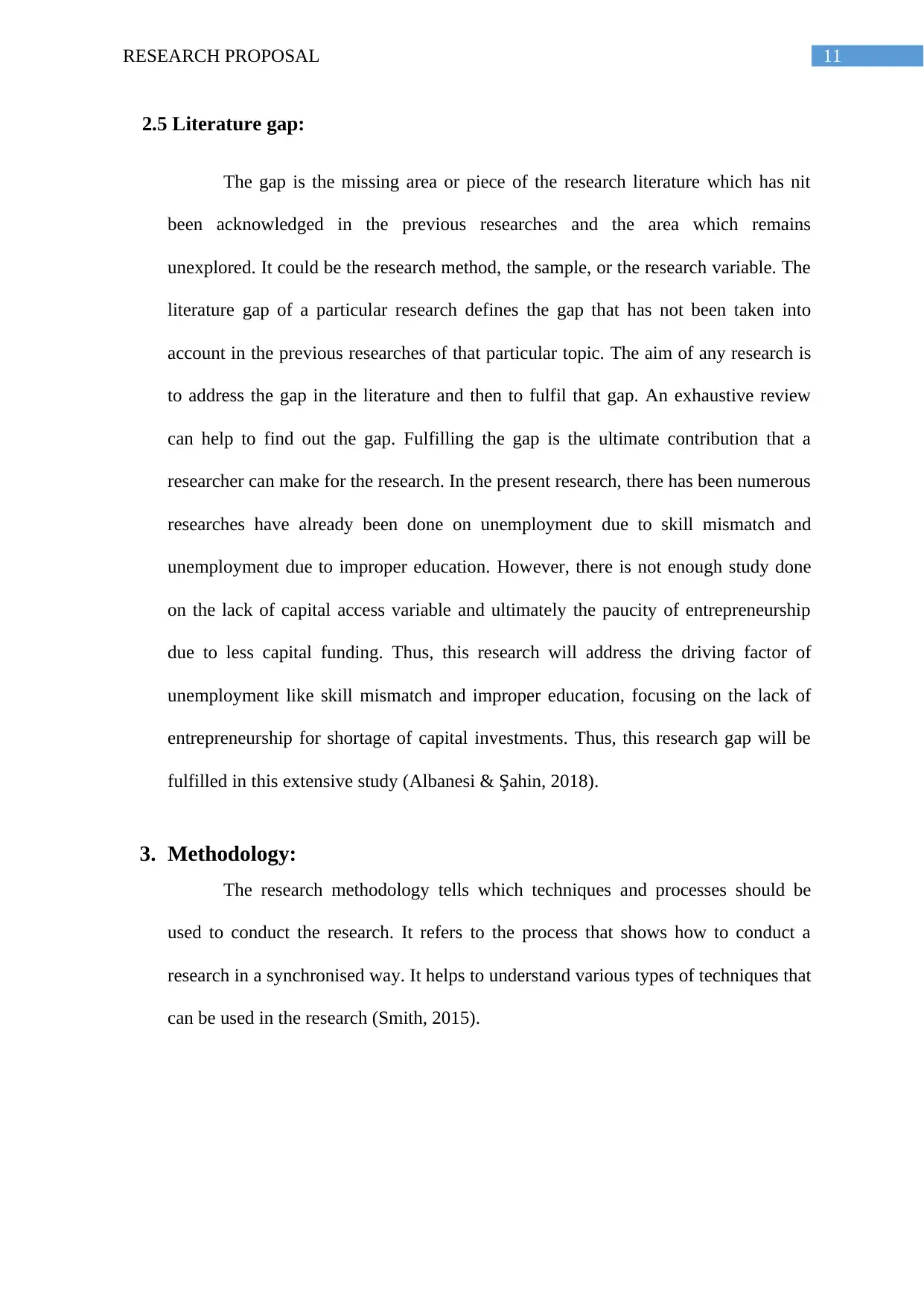
11RESEARCH PROPOSAL
2.5 Literature gap:
The gap is the missing area or piece of the research literature which has nit
been acknowledged in the previous researches and the area which remains
unexplored. It could be the research method, the sample, or the research variable. The
literature gap of a particular research defines the gap that has not been taken into
account in the previous researches of that particular topic. The aim of any research is
to address the gap in the literature and then to fulfil that gap. An exhaustive review
can help to find out the gap. Fulfilling the gap is the ultimate contribution that a
researcher can make for the research. In the present research, there has been numerous
researches have already been done on unemployment due to skill mismatch and
unemployment due to improper education. However, there is not enough study done
on the lack of capital access variable and ultimately the paucity of entrepreneurship
due to less capital funding. Thus, this research will address the driving factor of
unemployment like skill mismatch and improper education, focusing on the lack of
entrepreneurship for shortage of capital investments. Thus, this research gap will be
fulfilled in this extensive study (Albanesi & Şahin, 2018).
3. Methodology:
The research methodology tells which techniques and processes should be
used to conduct the research. It refers to the process that shows how to conduct a
research in a synchronised way. It helps to understand various types of techniques that
can be used in the research (Smith, 2015).
2.5 Literature gap:
The gap is the missing area or piece of the research literature which has nit
been acknowledged in the previous researches and the area which remains
unexplored. It could be the research method, the sample, or the research variable. The
literature gap of a particular research defines the gap that has not been taken into
account in the previous researches of that particular topic. The aim of any research is
to address the gap in the literature and then to fulfil that gap. An exhaustive review
can help to find out the gap. Fulfilling the gap is the ultimate contribution that a
researcher can make for the research. In the present research, there has been numerous
researches have already been done on unemployment due to skill mismatch and
unemployment due to improper education. However, there is not enough study done
on the lack of capital access variable and ultimately the paucity of entrepreneurship
due to less capital funding. Thus, this research will address the driving factor of
unemployment like skill mismatch and improper education, focusing on the lack of
entrepreneurship for shortage of capital investments. Thus, this research gap will be
fulfilled in this extensive study (Albanesi & Şahin, 2018).
3. Methodology:
The research methodology tells which techniques and processes should be
used to conduct the research. It refers to the process that shows how to conduct a
research in a synchronised way. It helps to understand various types of techniques that
can be used in the research (Smith, 2015).
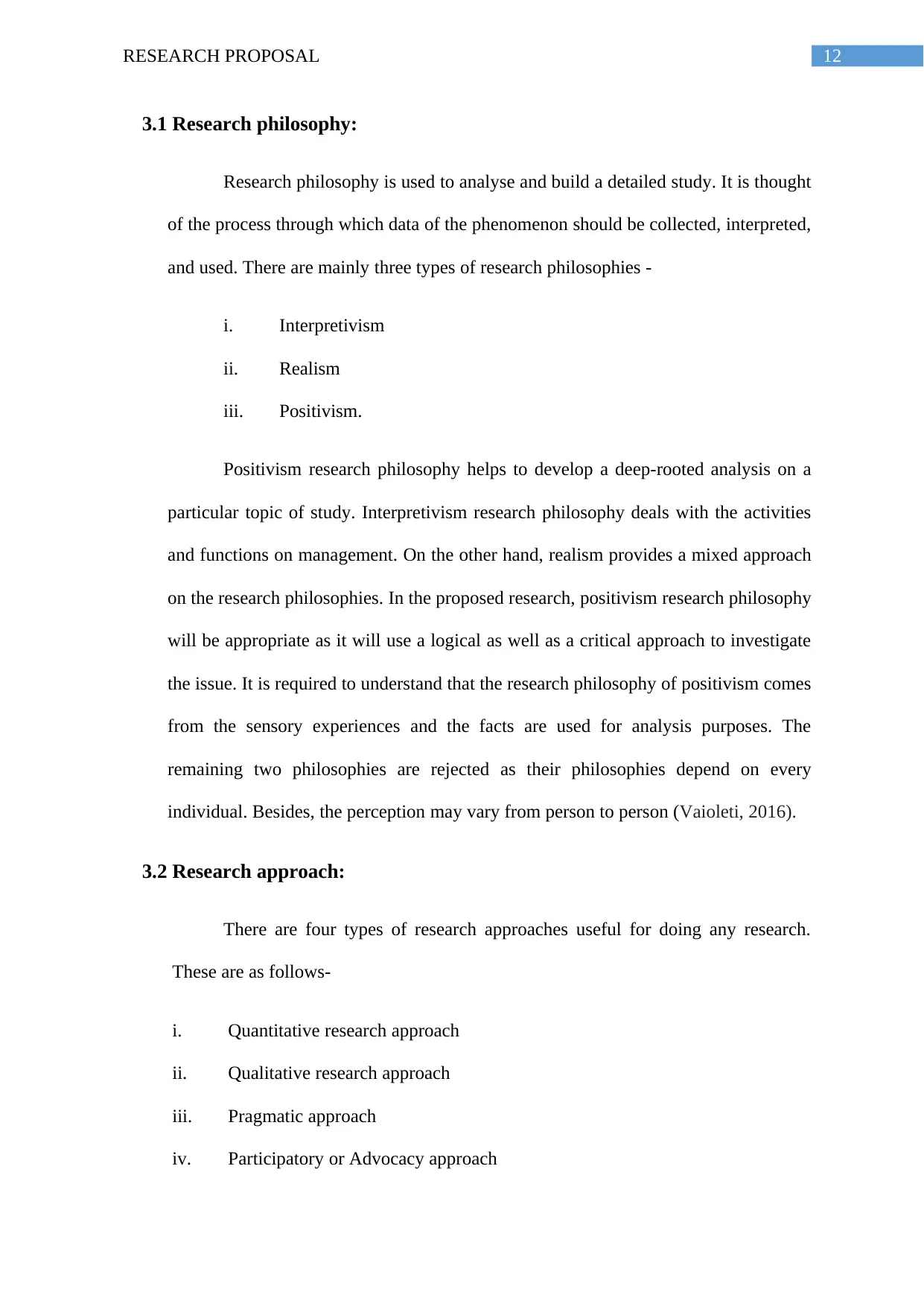
12RESEARCH PROPOSAL
3.1 Research philosophy:
Research philosophy is used to analyse and build a detailed study. It is thought
of the process through which data of the phenomenon should be collected, interpreted,
and used. There are mainly three types of research philosophies -
i. Interpretivism
ii. Realism
iii. Positivism.
Positivism research philosophy helps to develop a deep-rooted analysis on a
particular topic of study. Interpretivism research philosophy deals with the activities
and functions on management. On the other hand, realism provides a mixed approach
on the research philosophies. In the proposed research, positivism research philosophy
will be appropriate as it will use a logical as well as a critical approach to investigate
the issue. It is required to understand that the research philosophy of positivism comes
from the sensory experiences and the facts are used for analysis purposes. The
remaining two philosophies are rejected as their philosophies depend on every
individual. Besides, the perception may vary from person to person (Vaioleti, 2016).
3.2 Research approach:
There are four types of research approaches useful for doing any research.
These are as follows-
i. Quantitative research approach
ii. Qualitative research approach
iii. Pragmatic approach
iv. Participatory or Advocacy approach
3.1 Research philosophy:
Research philosophy is used to analyse and build a detailed study. It is thought
of the process through which data of the phenomenon should be collected, interpreted,
and used. There are mainly three types of research philosophies -
i. Interpretivism
ii. Realism
iii. Positivism.
Positivism research philosophy helps to develop a deep-rooted analysis on a
particular topic of study. Interpretivism research philosophy deals with the activities
and functions on management. On the other hand, realism provides a mixed approach
on the research philosophies. In the proposed research, positivism research philosophy
will be appropriate as it will use a logical as well as a critical approach to investigate
the issue. It is required to understand that the research philosophy of positivism comes
from the sensory experiences and the facts are used for analysis purposes. The
remaining two philosophies are rejected as their philosophies depend on every
individual. Besides, the perception may vary from person to person (Vaioleti, 2016).
3.2 Research approach:
There are four types of research approaches useful for doing any research.
These are as follows-
i. Quantitative research approach
ii. Qualitative research approach
iii. Pragmatic approach
iv. Participatory or Advocacy approach
Paraphrase This Document
Need a fresh take? Get an instant paraphrase of this document with our AI Paraphraser
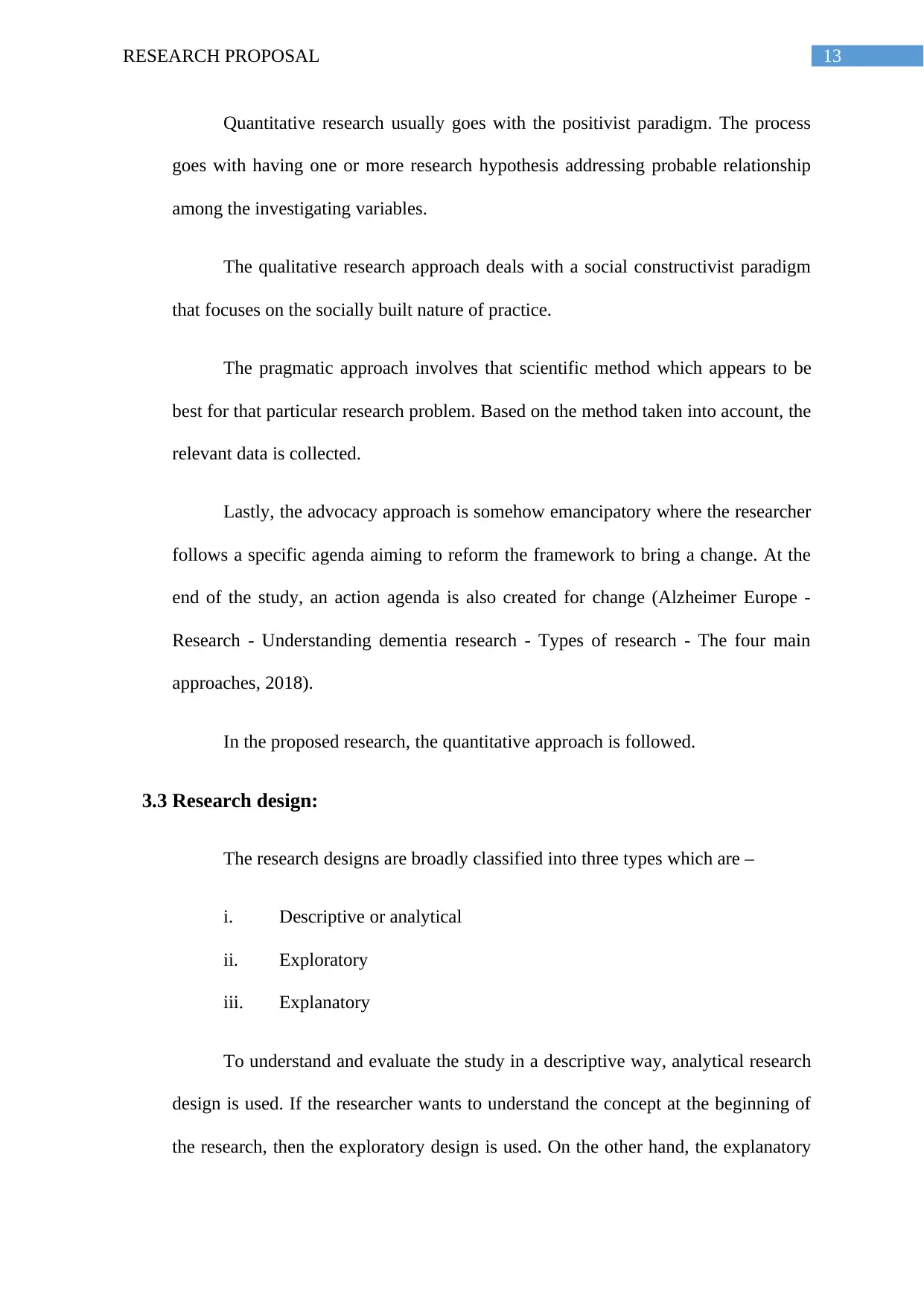
13RESEARCH PROPOSAL
Quantitative research usually goes with the positivist paradigm. The process
goes with having one or more research hypothesis addressing probable relationship
among the investigating variables.
The qualitative research approach deals with a social constructivist paradigm
that focuses on the socially built nature of practice.
The pragmatic approach involves that scientific method which appears to be
best for that particular research problem. Based on the method taken into account, the
relevant data is collected.
Lastly, the advocacy approach is somehow emancipatory where the researcher
follows a specific agenda aiming to reform the framework to bring a change. At the
end of the study, an action agenda is also created for change (Alzheimer Europe -
Research - Understanding dementia research - Types of research - The four main
approaches, 2018).
In the proposed research, the quantitative approach is followed.
3.3 Research design:
The research designs are broadly classified into three types which are –
i. Descriptive or analytical
ii. Exploratory
iii. Explanatory
To understand and evaluate the study in a descriptive way, analytical research
design is used. If the researcher wants to understand the concept at the beginning of
the research, then the exploratory design is used. On the other hand, the explanatory
Quantitative research usually goes with the positivist paradigm. The process
goes with having one or more research hypothesis addressing probable relationship
among the investigating variables.
The qualitative research approach deals with a social constructivist paradigm
that focuses on the socially built nature of practice.
The pragmatic approach involves that scientific method which appears to be
best for that particular research problem. Based on the method taken into account, the
relevant data is collected.
Lastly, the advocacy approach is somehow emancipatory where the researcher
follows a specific agenda aiming to reform the framework to bring a change. At the
end of the study, an action agenda is also created for change (Alzheimer Europe -
Research - Understanding dementia research - Types of research - The four main
approaches, 2018).
In the proposed research, the quantitative approach is followed.
3.3 Research design:
The research designs are broadly classified into three types which are –
i. Descriptive or analytical
ii. Exploratory
iii. Explanatory
To understand and evaluate the study in a descriptive way, analytical research
design is used. If the researcher wants to understand the concept at the beginning of
the research, then the exploratory design is used. On the other hand, the explanatory
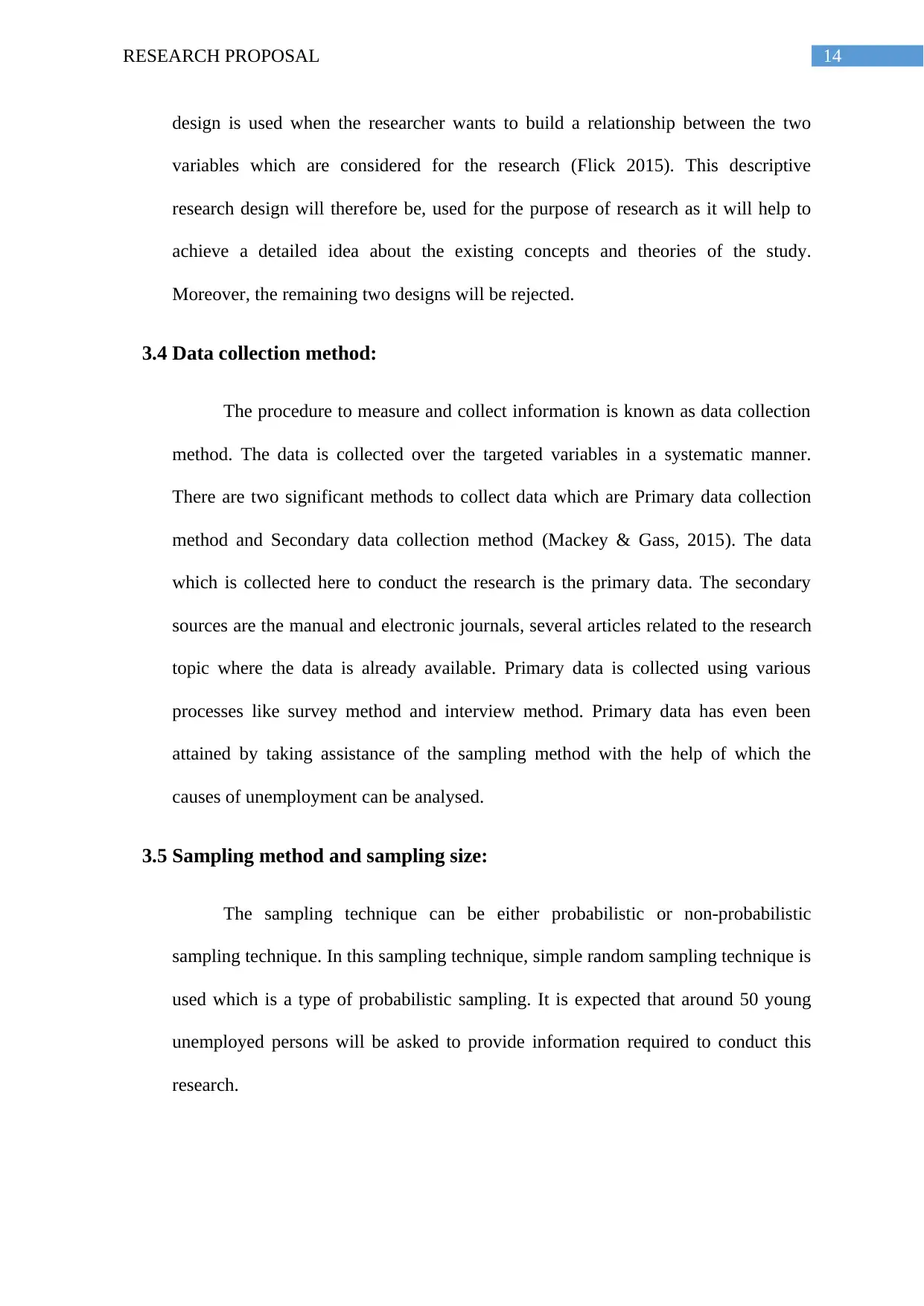
14RESEARCH PROPOSAL
design is used when the researcher wants to build a relationship between the two
variables which are considered for the research (Flick 2015). This descriptive
research design will therefore be, used for the purpose of research as it will help to
achieve a detailed idea about the existing concepts and theories of the study.
Moreover, the remaining two designs will be rejected.
3.4 Data collection method:
The procedure to measure and collect information is known as data collection
method. The data is collected over the targeted variables in a systematic manner.
There are two significant methods to collect data which are Primary data collection
method and Secondary data collection method (Mackey & Gass, 2015). The data
which is collected here to conduct the research is the primary data. The secondary
sources are the manual and electronic journals, several articles related to the research
topic where the data is already available. Primary data is collected using various
processes like survey method and interview method. Primary data has even been
attained by taking assistance of the sampling method with the help of which the
causes of unemployment can be analysed.
3.5 Sampling method and sampling size:
The sampling technique can be either probabilistic or non-probabilistic
sampling technique. In this sampling technique, simple random sampling technique is
used which is a type of probabilistic sampling. It is expected that around 50 young
unemployed persons will be asked to provide information required to conduct this
research.
design is used when the researcher wants to build a relationship between the two
variables which are considered for the research (Flick 2015). This descriptive
research design will therefore be, used for the purpose of research as it will help to
achieve a detailed idea about the existing concepts and theories of the study.
Moreover, the remaining two designs will be rejected.
3.4 Data collection method:
The procedure to measure and collect information is known as data collection
method. The data is collected over the targeted variables in a systematic manner.
There are two significant methods to collect data which are Primary data collection
method and Secondary data collection method (Mackey & Gass, 2015). The data
which is collected here to conduct the research is the primary data. The secondary
sources are the manual and electronic journals, several articles related to the research
topic where the data is already available. Primary data is collected using various
processes like survey method and interview method. Primary data has even been
attained by taking assistance of the sampling method with the help of which the
causes of unemployment can be analysed.
3.5 Sampling method and sampling size:
The sampling technique can be either probabilistic or non-probabilistic
sampling technique. In this sampling technique, simple random sampling technique is
used which is a type of probabilistic sampling. It is expected that around 50 young
unemployed persons will be asked to provide information required to conduct this
research.
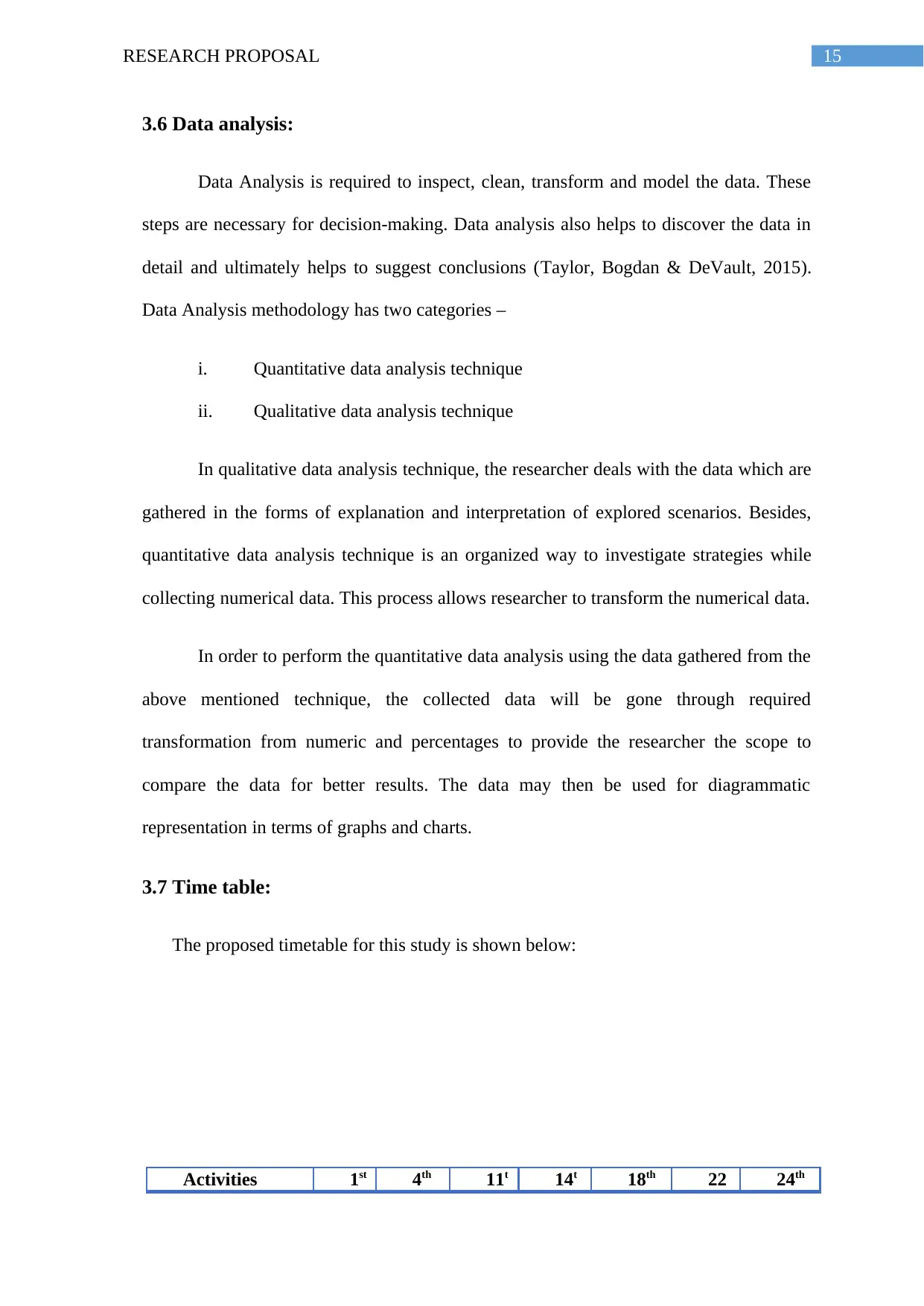
15RESEARCH PROPOSAL
3.6 Data analysis:
Data Analysis is required to inspect, clean, transform and model the data. These
steps are necessary for decision-making. Data analysis also helps to discover the data in
detail and ultimately helps to suggest conclusions (Taylor, Bogdan & DeVault, 2015).
Data Analysis methodology has two categories –
i. Quantitative data analysis technique
ii. Qualitative data analysis technique
In qualitative data analysis technique, the researcher deals with the data which are
gathered in the forms of explanation and interpretation of explored scenarios. Besides,
quantitative data analysis technique is an organized way to investigate strategies while
collecting numerical data. This process allows researcher to transform the numerical data.
In order to perform the quantitative data analysis using the data gathered from the
above mentioned technique, the collected data will be gone through required
transformation from numeric and percentages to provide the researcher the scope to
compare the data for better results. The data may then be used for diagrammatic
representation in terms of graphs and charts.
3.7 Time table:
The proposed timetable for this study is shown below:
Activities 1st 4th 11t 14t 18th 22 24th
3.6 Data analysis:
Data Analysis is required to inspect, clean, transform and model the data. These
steps are necessary for decision-making. Data analysis also helps to discover the data in
detail and ultimately helps to suggest conclusions (Taylor, Bogdan & DeVault, 2015).
Data Analysis methodology has two categories –
i. Quantitative data analysis technique
ii. Qualitative data analysis technique
In qualitative data analysis technique, the researcher deals with the data which are
gathered in the forms of explanation and interpretation of explored scenarios. Besides,
quantitative data analysis technique is an organized way to investigate strategies while
collecting numerical data. This process allows researcher to transform the numerical data.
In order to perform the quantitative data analysis using the data gathered from the
above mentioned technique, the collected data will be gone through required
transformation from numeric and percentages to provide the researcher the scope to
compare the data for better results. The data may then be used for diagrammatic
representation in terms of graphs and charts.
3.7 Time table:
The proposed timetable for this study is shown below:
Activities 1st 4th 11t 14t 18th 22 24th
Secure Best Marks with AI Grader
Need help grading? Try our AI Grader for instant feedback on your assignments.

16RESEARCH PROPOSAL
to 3rd
Week
to 10th
week
h to
13th
Week
h to
17th
Week
to 21st
Week
nd to
23rd
Week
Week
Selection of the
topic
Data collection
from secondary
sources
Creating layout
Literature review
Analysis and
interpretation of
collected data
Findings of the
data
Conclusion of the
study
Formation of draft
Submission of
final work
Fig: Gantt Chart
(Source: As created by the author)
3.8 Ethical consideration:
When a research is conducted, the researcher is ought to follow certain ethical
norms and restrictions during the whole research process. According to the Data
to 3rd
Week
to 10th
week
h to
13th
Week
h to
17th
Week
to 21st
Week
nd to
23rd
Week
Week
Selection of the
topic
Data collection
from secondary
sources
Creating layout
Literature review
Analysis and
interpretation of
collected data
Findings of the
data
Conclusion of the
study
Formation of draft
Submission of
final work
Fig: Gantt Chart
(Source: As created by the author)
3.8 Ethical consideration:
When a research is conducted, the researcher is ought to follow certain ethical
norms and restrictions during the whole research process. According to the Data
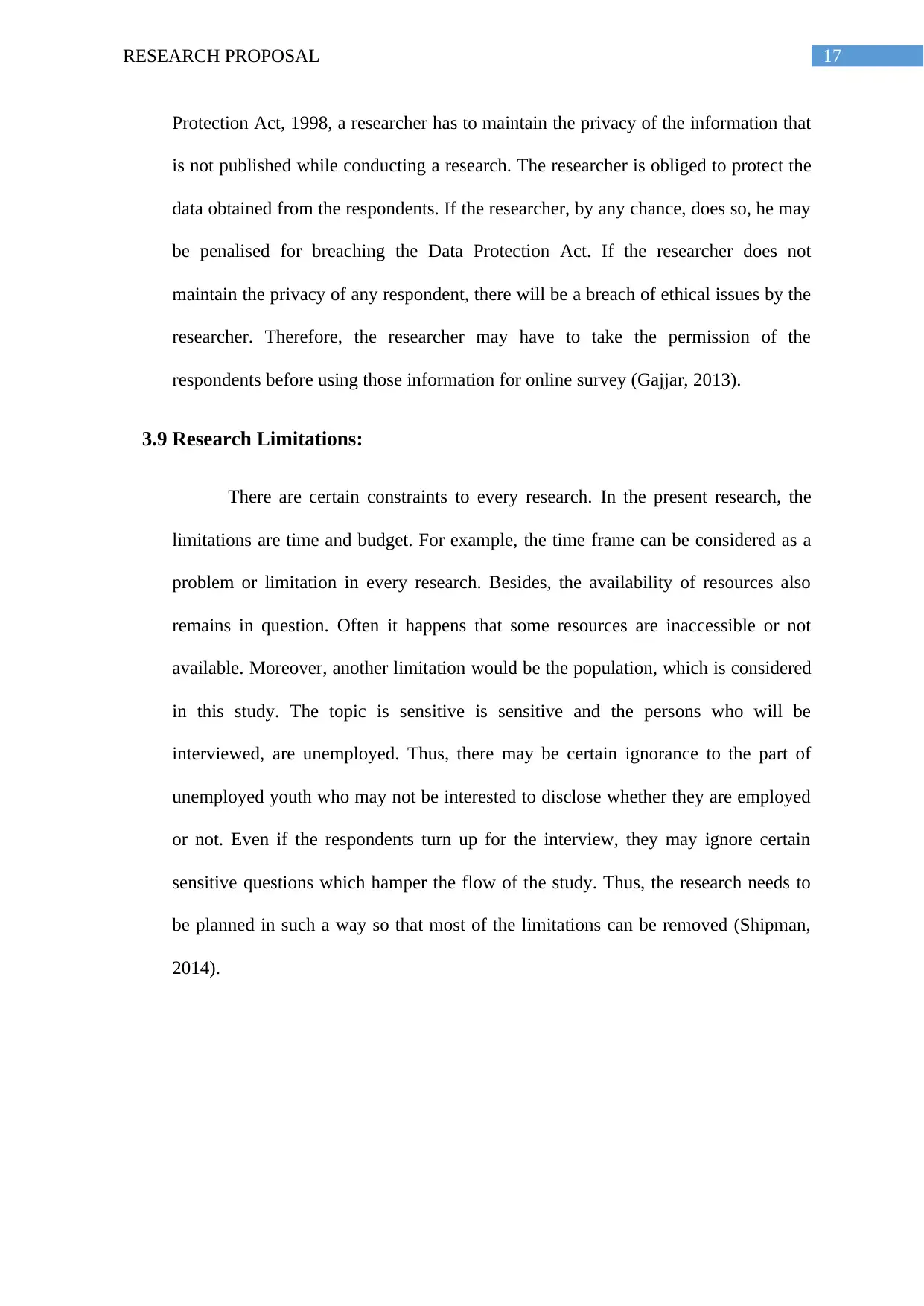
17RESEARCH PROPOSAL
Protection Act, 1998, a researcher has to maintain the privacy of the information that
is not published while conducting a research. The researcher is obliged to protect the
data obtained from the respondents. If the researcher, by any chance, does so, he may
be penalised for breaching the Data Protection Act. If the researcher does not
maintain the privacy of any respondent, there will be a breach of ethical issues by the
researcher. Therefore, the researcher may have to take the permission of the
respondents before using those information for online survey (Gajjar, 2013).
3.9 Research Limitations:
There are certain constraints to every research. In the present research, the
limitations are time and budget. For example, the time frame can be considered as a
problem or limitation in every research. Besides, the availability of resources also
remains in question. Often it happens that some resources are inaccessible or not
available. Moreover, another limitation would be the population, which is considered
in this study. The topic is sensitive is sensitive and the persons who will be
interviewed, are unemployed. Thus, there may be certain ignorance to the part of
unemployed youth who may not be interested to disclose whether they are employed
or not. Even if the respondents turn up for the interview, they may ignore certain
sensitive questions which hamper the flow of the study. Thus, the research needs to
be planned in such a way so that most of the limitations can be removed (Shipman,
2014).
Protection Act, 1998, a researcher has to maintain the privacy of the information that
is not published while conducting a research. The researcher is obliged to protect the
data obtained from the respondents. If the researcher, by any chance, does so, he may
be penalised for breaching the Data Protection Act. If the researcher does not
maintain the privacy of any respondent, there will be a breach of ethical issues by the
researcher. Therefore, the researcher may have to take the permission of the
respondents before using those information for online survey (Gajjar, 2013).
3.9 Research Limitations:
There are certain constraints to every research. In the present research, the
limitations are time and budget. For example, the time frame can be considered as a
problem or limitation in every research. Besides, the availability of resources also
remains in question. Often it happens that some resources are inaccessible or not
available. Moreover, another limitation would be the population, which is considered
in this study. The topic is sensitive is sensitive and the persons who will be
interviewed, are unemployed. Thus, there may be certain ignorance to the part of
unemployed youth who may not be interested to disclose whether they are employed
or not. Even if the respondents turn up for the interview, they may ignore certain
sensitive questions which hamper the flow of the study. Thus, the research needs to
be planned in such a way so that most of the limitations can be removed (Shipman,
2014).
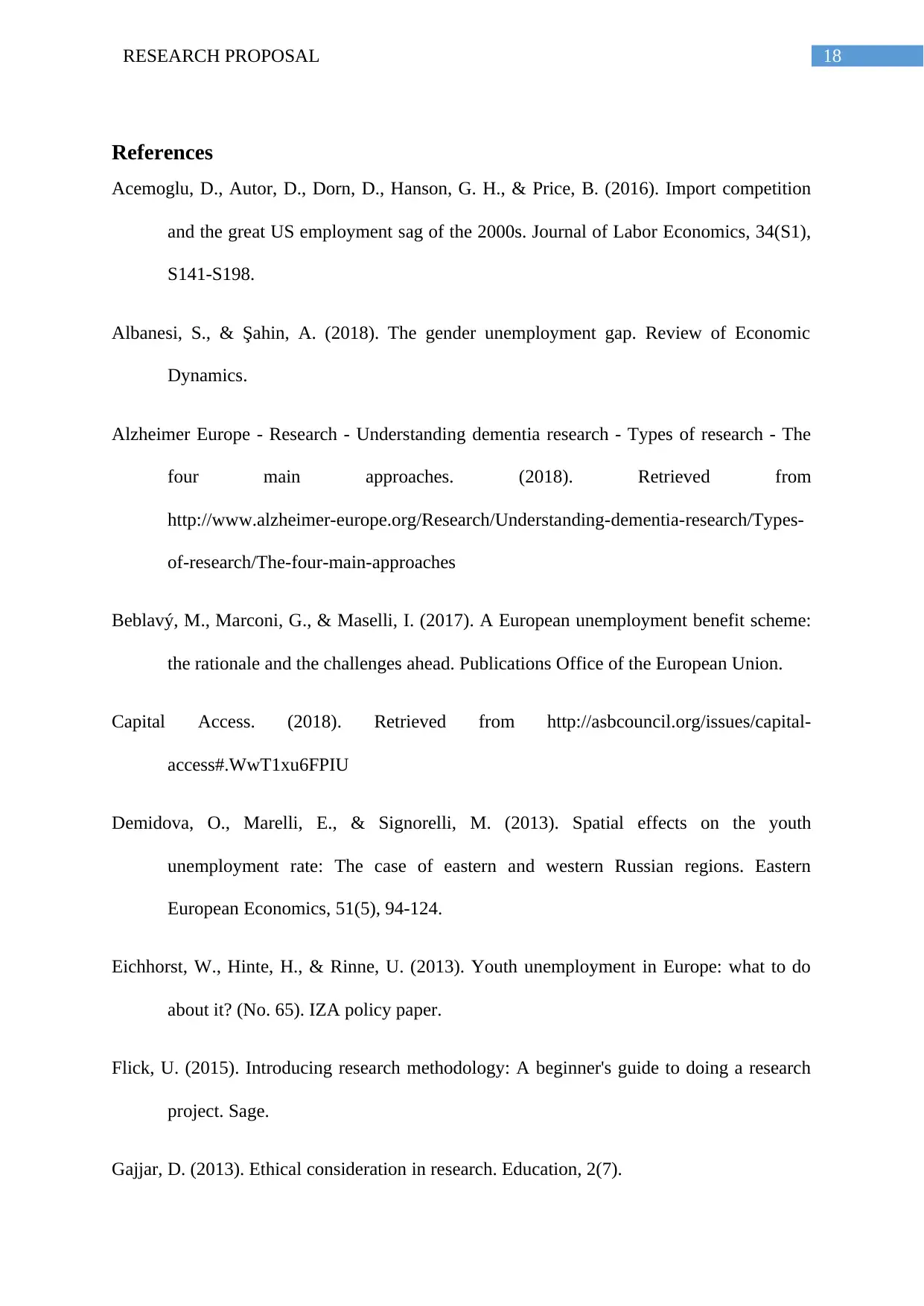
18RESEARCH PROPOSAL
References
Acemoglu, D., Autor, D., Dorn, D., Hanson, G. H., & Price, B. (2016). Import competition
and the great US employment sag of the 2000s. Journal of Labor Economics, 34(S1),
S141-S198.
Albanesi, S., & Şahin, A. (2018). The gender unemployment gap. Review of Economic
Dynamics.
Alzheimer Europe - Research - Understanding dementia research - Types of research - The
four main approaches. (2018). Retrieved from
http://www.alzheimer-europe.org/Research/Understanding-dementia-research/Types-
of-research/The-four-main-approaches
Beblavý, M., Marconi, G., & Maselli, I. (2017). A European unemployment benefit scheme:
the rationale and the challenges ahead. Publications Office of the European Union.
Capital Access. (2018). Retrieved from http://asbcouncil.org/issues/capital-
access#.WwT1xu6FPIU
Demidova, O., Marelli, E., & Signorelli, M. (2013). Spatial effects on the youth
unemployment rate: The case of eastern and western Russian regions. Eastern
European Economics, 51(5), 94-124.
Eichhorst, W., Hinte, H., & Rinne, U. (2013). Youth unemployment in Europe: what to do
about it? (No. 65). IZA policy paper.
Flick, U. (2015). Introducing research methodology: A beginner's guide to doing a research
project. Sage.
Gajjar, D. (2013). Ethical consideration in research. Education, 2(7).
References
Acemoglu, D., Autor, D., Dorn, D., Hanson, G. H., & Price, B. (2016). Import competition
and the great US employment sag of the 2000s. Journal of Labor Economics, 34(S1),
S141-S198.
Albanesi, S., & Şahin, A. (2018). The gender unemployment gap. Review of Economic
Dynamics.
Alzheimer Europe - Research - Understanding dementia research - Types of research - The
four main approaches. (2018). Retrieved from
http://www.alzheimer-europe.org/Research/Understanding-dementia-research/Types-
of-research/The-four-main-approaches
Beblavý, M., Marconi, G., & Maselli, I. (2017). A European unemployment benefit scheme:
the rationale and the challenges ahead. Publications Office of the European Union.
Capital Access. (2018). Retrieved from http://asbcouncil.org/issues/capital-
access#.WwT1xu6FPIU
Demidova, O., Marelli, E., & Signorelli, M. (2013). Spatial effects on the youth
unemployment rate: The case of eastern and western Russian regions. Eastern
European Economics, 51(5), 94-124.
Eichhorst, W., Hinte, H., & Rinne, U. (2013). Youth unemployment in Europe: what to do
about it? (No. 65). IZA policy paper.
Flick, U. (2015). Introducing research methodology: A beginner's guide to doing a research
project. Sage.
Gajjar, D. (2013). Ethical consideration in research. Education, 2(7).
Paraphrase This Document
Need a fresh take? Get an instant paraphrase of this document with our AI Paraphraser

19RESEARCH PROPOSAL
Görlich, D., Stepanok, I., & Al-Hussami, F. (2013). Youth unemployment in Europe and the
world: Causes, consequences and solutions (No. 59). Kiel Policy Brief, IfW.
Mackey, A., & Gass, S. M. (2015). Second language research: Methodology and design.
Routledge.
Maqbool, M. S., Mahmood, T., Sattar, A., & Bhalli, M. N. (2013). Determinants of
unemployment: Empirical evidences from Pakistan. Pakistan Economic and Social
Review, 191c-208.
Milner, A., Page, A., & Lamontagne, A. D. (2014). Cause and effect in studies on
unemployment, mental health and suicide: a meta-analytic and conceptual review.
Psychological medicine, 44(5), 909-917.
Okoye, A. C. (2017). Entrepreneurship Education: A Panacea for Graduate Unemployment in
Nigeria. Online Journal of Arts, Management & Social Sciences, 2(1).
Otekhile, C. A., & Zeleny, M. (2016). Self Service Technologies: A Cause of
Unemployment. International Journal of Entrepreneurial Knowledge, 4(1), 60-71.
Poor quality education and care. (2018). Retrieved from
http://www.ero.govt.nz/publications/quality-in-early-childhood-services/poor-quality-
education-and-care/
Restrepo, P. (2015). Skill Mismatch and Structural Unemployment. Unpublished manuscript.
Salami, C. G. E. (2013). Youth unemployment in Nigeria: A time for creative intervention.
International Journal of Business and Marketing Management, 1(2), 18-26.
Shipman, M. D. (2014). The limitations of social research. Routledge.
Görlich, D., Stepanok, I., & Al-Hussami, F. (2013). Youth unemployment in Europe and the
world: Causes, consequences and solutions (No. 59). Kiel Policy Brief, IfW.
Mackey, A., & Gass, S. M. (2015). Second language research: Methodology and design.
Routledge.
Maqbool, M. S., Mahmood, T., Sattar, A., & Bhalli, M. N. (2013). Determinants of
unemployment: Empirical evidences from Pakistan. Pakistan Economic and Social
Review, 191c-208.
Milner, A., Page, A., & Lamontagne, A. D. (2014). Cause and effect in studies on
unemployment, mental health and suicide: a meta-analytic and conceptual review.
Psychological medicine, 44(5), 909-917.
Okoye, A. C. (2017). Entrepreneurship Education: A Panacea for Graduate Unemployment in
Nigeria. Online Journal of Arts, Management & Social Sciences, 2(1).
Otekhile, C. A., & Zeleny, M. (2016). Self Service Technologies: A Cause of
Unemployment. International Journal of Entrepreneurial Knowledge, 4(1), 60-71.
Poor quality education and care. (2018). Retrieved from
http://www.ero.govt.nz/publications/quality-in-early-childhood-services/poor-quality-
education-and-care/
Restrepo, P. (2015). Skill Mismatch and Structural Unemployment. Unpublished manuscript.
Salami, C. G. E. (2013). Youth unemployment in Nigeria: A time for creative intervention.
International Journal of Business and Marketing Management, 1(2), 18-26.
Shipman, M. D. (2014). The limitations of social research. Routledge.
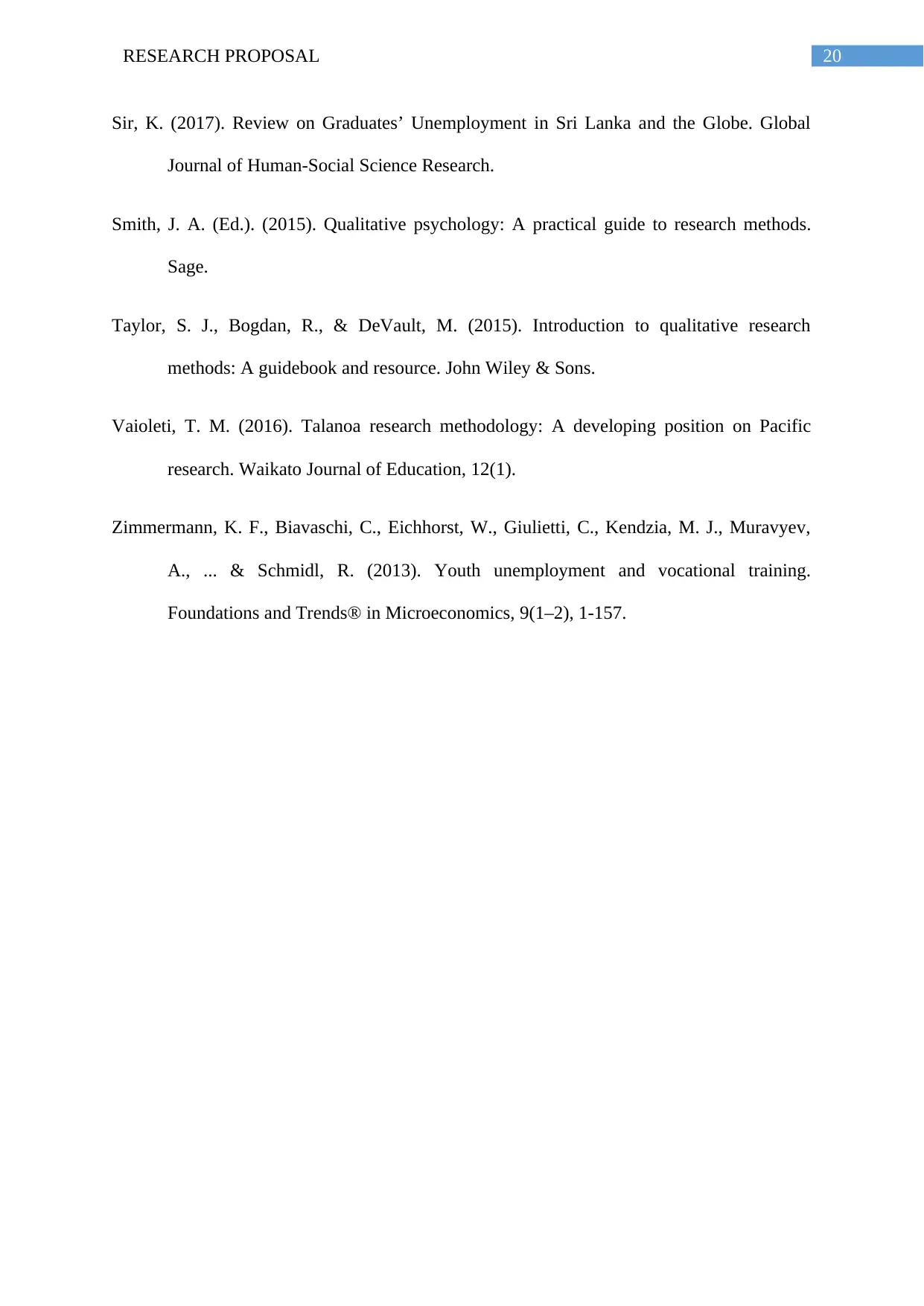
20RESEARCH PROPOSAL
Sir, K. (2017). Review on Graduates’ Unemployment in Sri Lanka and the Globe. Global
Journal of Human-Social Science Research.
Smith, J. A. (Ed.). (2015). Qualitative psychology: A practical guide to research methods.
Sage.
Taylor, S. J., Bogdan, R., & DeVault, M. (2015). Introduction to qualitative research
methods: A guidebook and resource. John Wiley & Sons.
Vaioleti, T. M. (2016). Talanoa research methodology: A developing position on Pacific
research. Waikato Journal of Education, 12(1).
Zimmermann, K. F., Biavaschi, C., Eichhorst, W., Giulietti, C., Kendzia, M. J., Muravyev,
A., ... & Schmidl, R. (2013). Youth unemployment and vocational training.
Foundations and Trends® in Microeconomics, 9(1–2), 1-157.
Sir, K. (2017). Review on Graduates’ Unemployment in Sri Lanka and the Globe. Global
Journal of Human-Social Science Research.
Smith, J. A. (Ed.). (2015). Qualitative psychology: A practical guide to research methods.
Sage.
Taylor, S. J., Bogdan, R., & DeVault, M. (2015). Introduction to qualitative research
methods: A guidebook and resource. John Wiley & Sons.
Vaioleti, T. M. (2016). Talanoa research methodology: A developing position on Pacific
research. Waikato Journal of Education, 12(1).
Zimmermann, K. F., Biavaschi, C., Eichhorst, W., Giulietti, C., Kendzia, M. J., Muravyev,
A., ... & Schmidl, R. (2013). Youth unemployment and vocational training.
Foundations and Trends® in Microeconomics, 9(1–2), 1-157.
1 out of 21
Related Documents
Your All-in-One AI-Powered Toolkit for Academic Success.
+13062052269
info@desklib.com
Available 24*7 on WhatsApp / Email
![[object Object]](/_next/static/media/star-bottom.7253800d.svg)
Unlock your academic potential
© 2024 | Zucol Services PVT LTD | All rights reserved.





